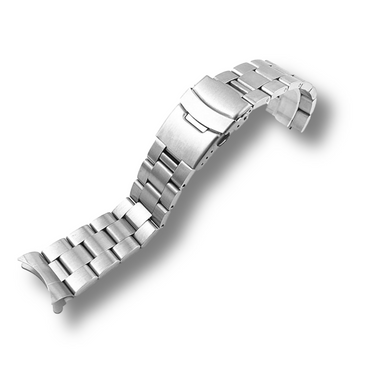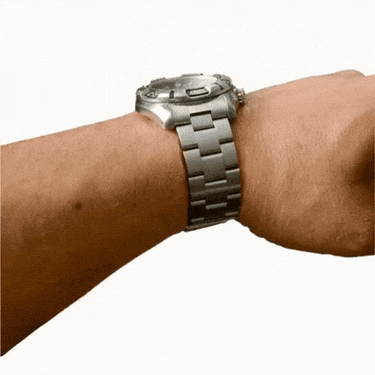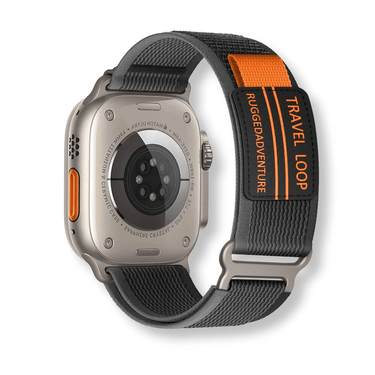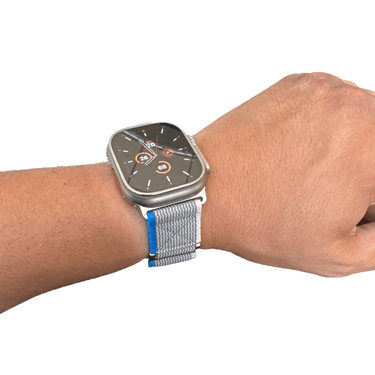The Importance of a Reliable Watchband for Outdoor Activities
When it comes to outdoor activities, having a reliable watchband is crucial. Not only does it help you keep track of time, but it also aids in navigation, especially if you don't have access to electronic devices.
A good watchband should be durable, comfortable, and able to withstand the harsh conditions of the outdoors. Wearing a watch while hiking, camping or engaging in other outdoor activities helps you stay on schedule and keep track of important things like meal times and trail distances.
If you're someone who enjoys spending time in nature, then having a reliable watch is essential. But what happens when your watchband breaks or fails during an outdoor adventure?
It can be incredibly frustrating not being able to know what time it is when your phone battery dies or losing your sense of direction because you no longer have a compass. Investing in a high-quality watch and making your own paracord watchband will prevent such disasters from happening.
The Benefits of Making Your Own Paracord Watchband
Making your own paracord watchband has several benefits over purchasing one from the store. Firstly, DIYing allows for customization which means that you can create something that looks and feels unique to you. You can choose colors that match your personal style or create patterns that are meaningful to you.
Secondly, learning how to make your own paracord wristbands can be an enjoyable hobby for those who enjoy working with their hands. It's not only fun but also rewarding with the additional satisfaction of knowing how practical these bands can be for outdoor adventures.
Thirdly, buying materials from stores allows one to acquire high-quality materials at affordable prices instead of committing oneself into purchasing expensive replacements every time one's conventional straps break down due to wear and tear. Making something by yourself fosters self-reliance and independence-qualities that outdoor enthusiasts cherish.
Gathering Materials
List of necessary materials and tools needed for making a paracord watchband
Making your own paracord watchband requires some essential materials and tools. First, you will need at least 10-12 feet of high-quality paracord.
The cord must be genuine 550 Parachute Cord, which is the most durable and reliable type of paracord available. Anything less than this standard will result in a less sturdy watchband that may fall apart during outdoor activities.
In addition to the paracord, you will need scissors or a cutting tool to cut the cord, a lighter or heat source to melt the ends of the cord for sealing purposes, and a buckle to secure the watchband around your wrist. Some optional supplies include beads or charms to add some personalization to your creation.
Creative tips on where to find high-quality paracord and other supplies
Finding high-quality supplies for making your own paracord watchband can be challenging but not impossible. First, you can check out outdoor gear stores such as REI or Cabela's that offer a wide range of choices when it comes to Parachute Cord.
Another option is visiting military surplus stores in your area as they often carry genuine 550 Parachute Cord used by military personnel. If you are looking for something unique or a specific color scheme that is hard to find elsewhere, online retailers such as Amazon offer an extensive selection of Parachute Cord suppliers.
For additional creative ideas on adding personalized touches with beads or charms, visit craft stores like Hobby Lobby or Micheals for an array of options. Having access to quality material is crucial when making your own Paracord Watchbands.
Taking advantage of outdoor gear stores, military surplus shops and online retailers offer an excellent resource base where high-quality cords can be found. With limitless possibilities for customization, craft stores are a great place to look for additional materials such as beads or charms.
Measuring and Cutting Paracord
The Importance of Properly Measured Paracord
In order to create a sturdy and reliable paracord watchband, it is essential to measure the cord with accuracy. Too little cord will result in an ill-fitting watchband, while too much cord will lead to bulkiness and discomfort. Inaccurate cutting can also compromise the integrity of the band, leaving you with a flimsy or weak product.
Step-by-step Instructions for Accurate Measurement and Cutting
To begin, wrap a piece of string or tape measure around your wrist at the position where you would like your watchband to sit. Add an inch or so to this measurement for comfort and adjustability. This number represents the minimum amount of cord you will need.
Next, use scissors or a sharp knife to cut your paracord at this measured length. Be sure to cut straight across and avoid frayed edges.
Creative Tips for Ensuring Accuracy
One creative tip for ensuring accuracy in measurement is to use a flexible ruler that can wrap around your wrist. This type of ruler allows for more precise measurements than a standard straight ruler.
Another tip is to use a marker or tape on your paracord before cutting it. This will help ensure that you have an even cut across all strands of the cord.
Always double-check your measurements before starting any weaving techniques. It's much easier (and less frustrating) to measure twice than having to start over from scratch because of inaccuracies in measuring or cutting.
Don't Cut Corners on Cutting
Properly measured and cut paracord is essential for creating a high-quality watchband that will withstand even the toughest outdoor activities. Don't be tempted to cut corners on this step - take your time and ensure that your measurements are accurate. A well-made watchband will not only be a functional accessory but also a source of pride and accomplishment for the DIY enthusiast.
Weaving Techniques
Paracord Weaving: A Form of Art
When it comes to weaving techniques for paracord watchbands, there are endless possibilities. The beauty of paracord weaving lies in its versatility and artistry. It is not just a mere technique but a form of art that allows you to express your creativity and personality in your watchband.
One of the most popular weaving techniques is the cobra weave, also known as the Solomon bar. It is a simple yet elegant weave that consists of two parallel cords weaved together with a third cord.
The result is a sturdy and stylish band that can withstand any outdoor activity. However, don't limit yourself to just one weaving technique.
Experiment with different patterns and colors to create unique designs that match your style and personality. Try out other techniques like the king cobra or the fishtail weave, or even combine multiple weaves to create one-of-a-kind designs.
Breaking Down Different Weaving Techniques
While there are many different weaving techniques out there, let's focus on three popular ones: the cobra weave, king cobra weave, and fishtail weave. The cobra weave (Solomon bar) involves interlocking two strands (or more for thicker bands) through loops in an over-and-under pattern until reaching the desired length. This basic pattern creates a raised bump down the center of your band which adds visual texture.
The king cobra weave takes it up another notch by adding another layer onto the basic cobra pattern once it has reached its desired length. This creates an even bulkier/bold look sporting either contrasting colors or more subdued shades for a sleeker finish
We have the fishtail weave which has become increasingly popular due to its simplicity yet intricate design when completed successfully. To do this technique you have two base cords, and you weave two additional cords alternatively over and under the base cords until it reaches the desired length.
Experimenting with Patterns and Colors
Once you have mastered these three popular weaving techniques, it is time to experiment with different patterns and colors. You can get creative with color combinations, such as pairing bright neon colors for a vibrant look or darker shades for a more subtle watchband. You can also experiment with patterns by alternating between different weaving techniques in one band or even adding beads or charms throughout your design.
The possibilities are endless, and the only limit is your imagination. Paracord weaving is an art that requires patience and creativity.
Once mastered though it will open up a world of design possibilities! Do not hesitate to step outside the box when designing your own personal watchband from scratch.
Adding Buckles
The Importance of Choosing the Right Buckle
When it comes to choosing the right buckle for your paracord watchband, it's important to take into consideration the type of outdoor activities you will be engaging in. For example, if you are planning on using your watchband for water activities such as swimming or rafting, a plastic buckle would be the best choice as it is lightweight and waterproof.
However, if your activities involve hiking or rock climbing, a metal buckle would be more durable and reliable. Another factor to consider when choosing a buckle is its size and shape.
A larger buckle may be more comfortable for those with larger wrists while a smaller one may be better suited for those with smaller wrists. The shape of the buckle also plays a role in comfort and functionality - a curved or contoured buckle will fit more comfortably on the wrist than a flat one.
Step-by-Step Instructions on Adding Buckles
Now that you've chosen the right type of buckle for your paracord watchband, it's time to add it on! Here are some step-by-step instructions:
- Once you've woven your desired length of paracord, measure out about an inch from each end and fold them over. 2. Take one end of the folded paracord and insert it into one end of the buckle.
- Loop it back through itself so that it forms a knot around the bar on the inside of the buckle. 4. Pull tight to secure.
- Repeat steps 2-4 on the other side with the remaining folded paracord. It's important to note that when adding buckles to your paracord watchband, precision is key - make sure both ends are secured tightly so that they do not come undone during use.
Creative Tips
Adding a buckle to your paracord watchband doesn't have to be a boring task - there are many creative ways to customize and personalize your watchband with different types of buckles. One idea is to use a decorative buckle, such as one with a unique design or color.
This can add an extra pop of personality to your watchband and make it stand out from the crowd. Another creative tip is to use multiple buckles on one watchband - this can create an interesting layered look and also provide extra security for outdoor activities where the watch may be subject to more wear and tear.
Overall, adding a buckle to your paracord watchband is not only functional but also an opportunity for creativity and personalization. Take these tips into consideration when choosing the right type of buckle and adding it on, and you're sure to have a reliable and stylish accessory for all your outdoor adventures.
Finishing Touches
Trimming Excess Cord and Securing Knots
Congratulations! You've reached the final step in making your own paracord watchband.
Now it's time to trim the excess cord and secure your knots. Trimming excess cord can be daunting, but with a steady hand and a sharp pair of scissors, you'll have it done in no time.
Make sure to leave enough cord to weave through the last row of knots. Once you've trimmed the excess, use a lighter to melt the ends of the cord to prevent fraying.
Now it's time to secure your knots. This is an important step because you don't want your watch falling apart on your next outdoor adventure.
Use pliers or your fingers to gently tug on each knot to make sure they're tight and won't come undone. If necessary, add a dab of glue or clear nail polish over each knot for extra security.
Adding Personal Touches: Charms and Beads
Why settle for a plain old paracord watchband when you can add some personal touches? Get creative with charms or beads that reflect your style or interests.
Charms are an easy way to add personality without adding bulk. Choose from a wide variety of shapes such as animals, sports themes, favorite hobby or pastime figures etc.. Simply slide one onto the watch band before attaching the buckle.
Beads give even more options for creativity - there are so many choices! Select colors that match with either what you’re wearing or where you’re going; smooth combinations like earthy browns mixed with greens would go well with forest hiking while vibrant blues and purples could work well in coastal regions.
You can also choose different sizes depending on how much flair you want to add. Once you've added any additional touches like charms or beads, don't forget to trim any excess cord and secure the knots as previously outlined.
Conclusion
Congratulations! You’ve successfully made your own paracord watchband with extra personal touches added.
It may have taken some time and patience, but the outcome is worth it. Remember that making your own watchband isn't just a fun craft project - it's also practical for outdoor enthusiasts looking for a durable and reliable accessory.
With this guide, you'll now be able to make one to your liking. The best part?
You can experiment with different colors, patterns, and techniques to create a unique watchband that reflects your personality. Happy crafting!
ConclusionSummary of Key Points Covered in Guide:
In this step-by-step guide, we've covered everything you need to know to make your own paracord watchbands for all your outdoor adventures. We started by explaining the importance of having a reliable watchband and the benefits of making your own.
Next, we discussed the necessary materials and tools needed for making a paracord watchband, along with creative tips on where to find high-quality supplies. We then dove into measuring and cutting paracord, where we provided detailed instructions on how to measure and cut the appropriate length of paracord for your wrist size.
We also offered creative suggestions on how to ensure accuracy in measurement and cutting. Next up were weaving techniques, where we explained several different patterns that can be used in creating a unique paracord watchband.
We also offered suggestions on experimenting with different colors for added flair. Adding buckles was also covered in detail, with step-by-step instructions on how to ensure a secure fit.
We covered finishing touches such as trimming excess cord and securing knots. Personal touches such as charms or beads were also encouraged to add extra character. Creative Encouragement for Readers to Try:
Now that you have all the knowledge needed to make your own custom paracord watchband, it's time to put it into practice! Don't be afraid to experiment with different patterns and colors – after all, the beauty of making something yourself is that it can truly be one-of-a-kind.
Making your own watchband is not only fulfilling but also practical – you'll have a reliable accessory for all your outdoor activities. Plus, it's a great way to show off your creativity while staying prepared for any adventure that comes your way.
So go ahead – gather up some high-quality supplies, follow our step-by-step guide, and create something amazing that you can wear with pride. Who knows, you might even inspire others to do the same!

























